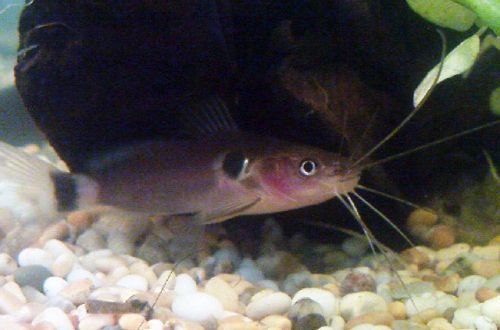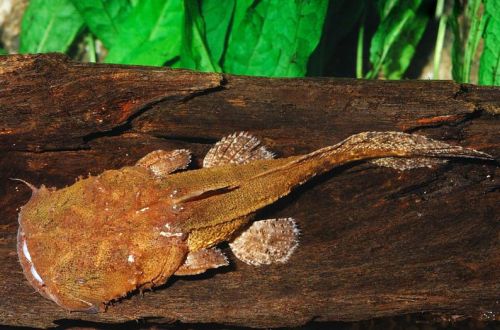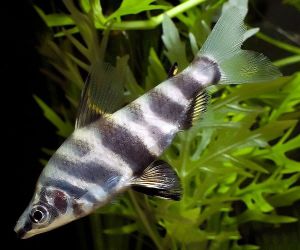
Malabar Danio
The Malabar Danio, scientific name Devario malabaricus, belongs to the Cyprinidae family. Easy to keep and breed. Able to get along with many freshwater species, making it an excellent candidate for your aquarium fish community.

Contents
Habitat
It comes from the Hindustan Peninsula and the island of Sri Lanka. The exact habitat has not been established, but it is probably limited to the west coast. The fish are found in rivers and streams flowing down from the Western Ghats mountains. The water bodies are characterized by clear running water, rocky substrates, high dissolved oxygen content and little coastal vegetation.
Brief information:
- The volume of the aquarium – from 200 liters.
- Temperature – 18-25°C
- Value pH — 6.0–8.0
- Water hardness – 2–15 dGH
- Substrate type — stony
- Lighting – any
- Brackish water – no
- Water movement – light or moderate
- The size of the fish is 7–8 cm.
- Food – any food
- Temperament – peaceful
- Keeping in a group of 8-10 individuals
Description
Adult individuals reach a length of about 7–8 cm. Unlike slender relatives, they have a rather heavy body. The color is gray-blue with rows of longitudinal yellow stripes and specks. Sexual dimorphism is weakly expressed, males are practically indistinguishable from females. The latter may look somewhat larger, especially during the spawning period, when they are filled with caviar.
Outwardly, it very much resembles the Giant Danio, which has led to a lot of confusion in the aquarium hobby. On sale, you can often find how the same species is sold immediately under two names. These two types are really similar. The main difference is in the tail, in the Malabar Danio it is deeply forked.
Food
Unpretentious and undemanding to the composition of the food look. Accepts most popular feeds. The daily diet can consist entirely of dry foods (flakes, granules). In this case, it is advisable to purchase feed from well-known and trusted manufacturers in order to be sure of the quality.
Maintenance and care, arrangement of the aquarium
For long-term maintenance, a tank of 200–250 liters is required. The design should resemble the bottom of a river in a mountainous area: a moderate current, soil of pebbles of variable size, boulders, a few snags, live or artificial plants. When choosing living plants, it is worth giving preference to unpretentious species that can survive in such conditions, for example, from among anubias, aquatic mosses and ferns.
The Malabar Danio needs high water quality with suitable hydrochemical values and does not tolerate the accumulation of organic waste. The aquarium must be equipped with a productive filtration system that not only purifies the water, but also is able to create the necessary flow. Additional aeration is welcome. Maintenance of the aquarium includes several standard procedures: cleaning the soil and glass, decoration elements, weekly replacement of part of the water (30–50% of the volume) with fresh water, equipment maintenance, monitoring and maintaining stable pH and dGH values.
Important! Danios can jump out of the water, so for their safety it is necessary to use a cover over the tank.
Behavior and Compatibility
Peaceful moving fish. Able to get along with many other freshwater species. However, their activity can negatively affect slow-moving fish. They prefer to be in a flock of 8-10 individuals, a single content will make Danio unnecessarily modest, shy and significantly reduce their life expectancy.
Breeding / breeding
Reproduction is typical of most Karpov. During the spawning period, fish lay many eggs directly on the ground or among plants. The incubation period lasts 24-36 hours, two days later the fry begin to swim freely. Parental instincts are not developed, so adult fish do not care about offspring, moreover, on occasion they will definitely eat their eggs or fry that have appeared. This explains the low survival rate of juveniles in a common aquarium.
In order to save the fry, you will need to prepare a separate tank where the eggs will be placed. Enough volume of 10-20 liters. The set of equipment includes a simple airlift filter with a sponge and a heater. The layout is arbitrary.
Fish diseases
In a balanced aquarium ecosystem with species-specific conditions, diseases rarely occur. Often, diseases are caused by environmental degradation, contact with sick fish, and injuries. If this could not be avoided and the fish shows clear signs of illness, then medical treatment will be required. Read more about symptoms and treatments in the Aquarium Fish Diseases section.





